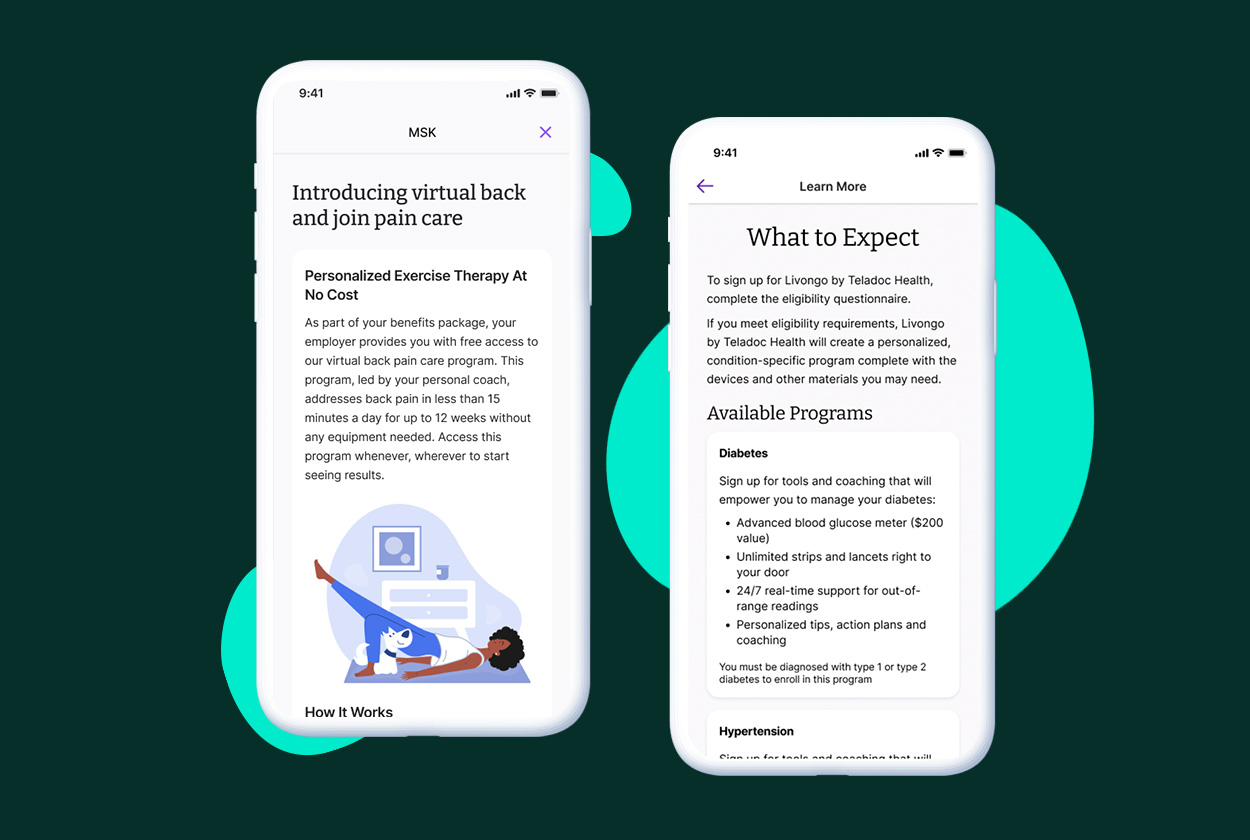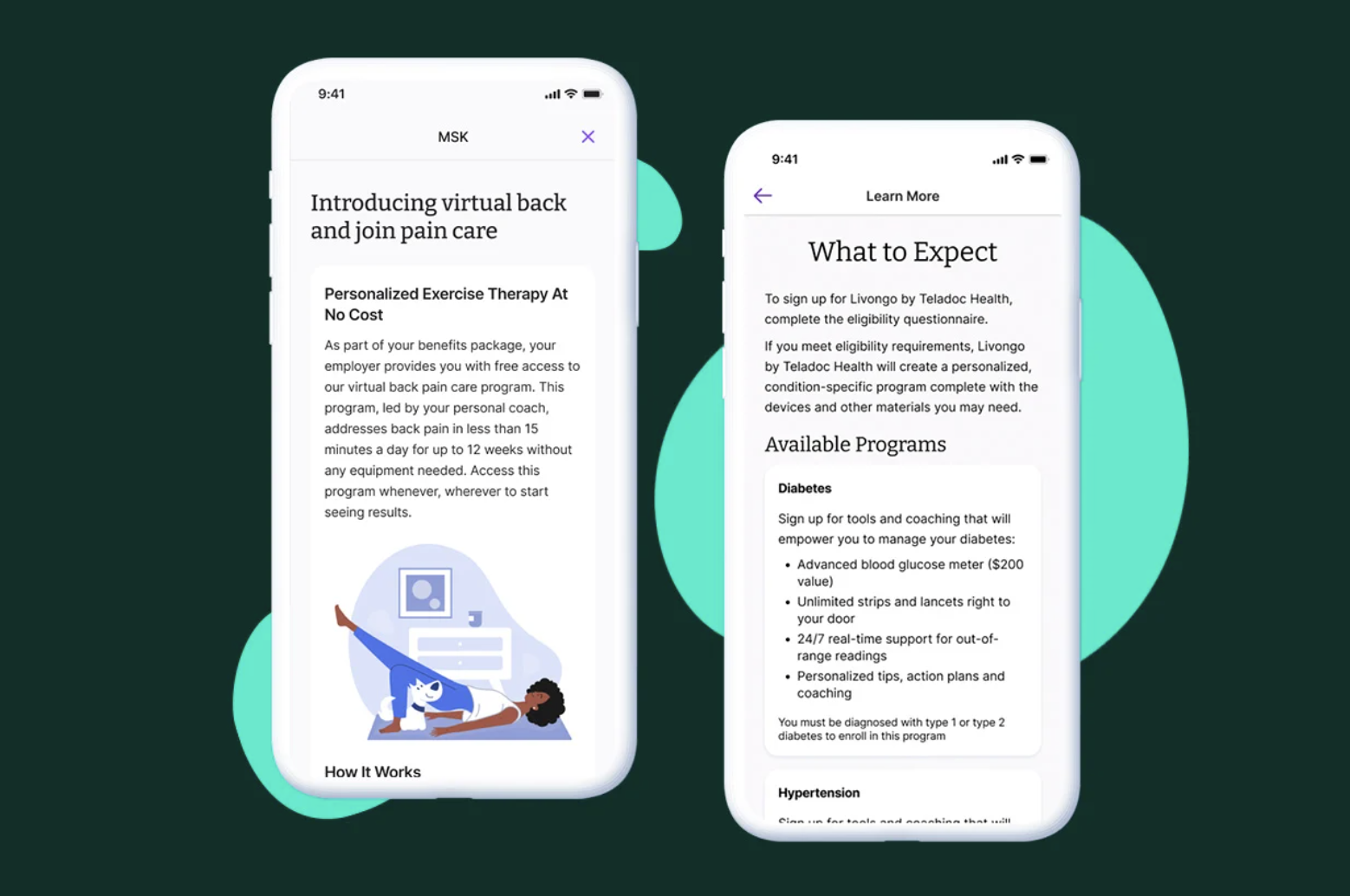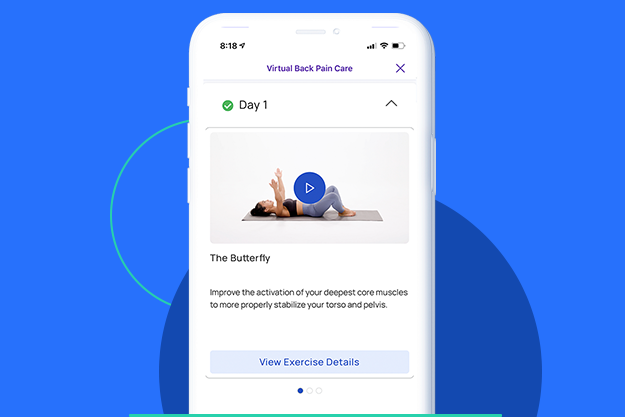Virtual MSK Therapy: Life-Changing and Cost-Saving
Suffering from a musculoskeletal (MSK) condition can make it feel like you’re on the sidelines in your own life. This pain can take you away from the...
Connected Navigation Platform
Guiding to high-value care
Behavioral Health
Foster a mentally healthy workplace
EAP
Supporting holistic wellbeing
Virtual MSK Care
Reimagining musculoskeletal care
Virtual Primary Care
Powered by smart navigation
Surgery Centers of Excellence
Best-in-class surgical outcomes
Virtual Urgent Care
Immediate care, any hour of the day
Chronic Care
A new approach to chronic care
Integrations
Flexible to any strategy

Chronic pain is an expensive problem. Musculoskeletal-related conditions account for $213 billion in annual treatment, care, and lost wages, making them the third-highest source of healthcare spending for 85% of employers.
And the impact goes deeper than the financial. Individuals struggling with musculoskeletal disorders will miss an average of 11.4 workdays per year, and up to 50% of them are experiencing depression. So what makes MSK care so expensive — and what can employers do about it?
According to the World Health Organization (WHO), MSK issues are characterized by persistent pain and limitations in mobility, dexterity, and overall level of functioning which affect a person’s ability to work. Musculoskeletal conditions are the leading contributor to disability worldwide, with low back pain being the single leading cause of disability in 160 countries.
To get MSK pain under control, patients have a few medical options:
These are direct medical costs.
Indirect costs are made up of earning and productivity losses, in addition to worker replacement, and are an important way MSK costs drive up employer spending.
Fact: MSK accounts for more than 216 million missed workdays.
To put it simply, employees looking to manage their MSK pain have few good options. Common treatments are expensive and don’t work. For example, the Centers for Disease Control and Prevention (CDC) recommends physical therapy for 95% of people with low back pain. But adherence to PT programs tends to be low. Participants need to commit to multiple sessions, often over weeks and months, and they have to manage the travel it takes to get there. The ongoing pandemic means that for many employees, in-person visits are less appealing than ever.
Instead, many end up seeing surgery as a “quick fix.” In fact, surgery accounts for over 70% of MSK spend, according to the United States Bone and Joint Initiative. Unfortunately, it doesn’t always work. Up to 40% of patients who get surgery continue to experience pain afterward. It’s so common it has a name — Failed Back Surgery Syndrome (FBSS).
To put FBSS into context, according to an NCBI return-to-work study on workers’ compensation cases, only 26% of people who got fusion surgery returned to work within two years, compared to 67% of those who didn’t get surgery.
The other alternative is to do nothing about MSK pain. Those employees might try to manage pain on their own or with medications. Without tending to the root cause of their pain, employees are likely to escalate their care.
Bonus: meet the humans behind our platform. While technology certainly enables us to connect our members to care, it’s the humans behind the platform that make it all possible. Introducing some of our Virtual MSK Care program coaches.
Chronic pain can also lead people to experience a costly cycle of surgery, imaging, and pain meds.
For example, a typical journey for the low back pain sufferer might look like this:
Based on data from our own provider and procedure search member requests, over half of people in this path search for a surgeon first, and skip the first three steps. This might not even include injections and prescriptions.
As the pandemic continues, we’ve observed that people tend to stay in the imaging step, taking drugs to relieve their pain, and then get another round of imaging the following year. If they don’t find answers, employees might end up stuck in this cycle until they turn to surgery.
A more optimal journey begins with exercise therapy. According to Johns Hopkins, only 5% of people with back pain are good candidates for surgery, while exercise therapy yields 60% lower costs over the proceeding two years. Unfortunately, because of barriers to access, not many end up taking this route.
We know that exercise therapy is an ideal first step for those suffering with MSK pain. Not only is it cost-effective, but it yields better results without the complications and recovery time associated with invasive surgery. Yet we know that most employees won’t turn to exercise therapy when they experience pain. HealthJoy is working to change this paradigm.
We created our Virtual MSK Care program to help tackle rising costs while giving employees real relief. This program aims to redefine pain management and physical care through a connected care experience that provides better health outcomes and lower claims spend.
As part of our core offering, our Virtual MSK Care program gives your employees access to our low-cost and effective solution. We’ve already kicked off the program with Virtual Back Pain Care, but we’ll be adding more programs to treat hip, shoulder, neck, and knee pain in early 2022.
From start to finish, the Virtual MSK Care program is designed for ease of use. Here’s a glimpse of how members can take the necessary steps to begin their healing journey.
 Steerage
SteerageIt starts with steerage. HealthJoy is uniquely positioned to redirect people who are searching for physical therapists, orthopedic surgeons, and other professionals toward our program, because existing members already rely on HealthJoy to find care. The program is available within the app so they can receive that recommendation and access it within minutes of starting their search. JOY will also proactively reach out to engage members and make them aware of Virtual MSK Care throughout the year.
 Intake
IntakeInterested members can then complete an intake survey on their medical history, pain history, mental health, and motivation, to apply for the program. On average, around 3-7% of an employee population will end up participating in the program. Typically, 5-10% of people who complete the intake survey are ineligible for the program based on their medical history.
 Intro call
Intro callEvery participant is assigned a personal coach to support them throughout the program. The program is highly personal; on average, members interact with their coach 40 times throughout treatment. The introductory call helps the coach understand the member’s unique situation, educates the member on their program and prepares them for Week 1, and helps the member schedule the exercises into their day so there’s a defined plan for adherence.
 Care
CareThe program requires 15 minutes a day, five days per week. Members can access the program at home or on the go, from their mobile device or desktop. No equipment is necessary. The coach will reach out to the member to make sure they’re following the program. Given the 50% correlation of back pain and depression, our intake survey also screens for behavioral health flags so that coaches can guide members to appropriate care based on their benefits.
 Maintenance
MaintenanceOnce the member completes their personalized program, they’ll receive a tailored maintenance plan they can access for an additional 12 months.
Back and joint pain are costing employers in both claims spend and indirect costs like productivity loss. Through our Virtual MSK Care program, your employees gain access to a no-cost, noninvasive treatment that reduces pain levels without resorting to medications, surgeries, or in-person visits.
See it in action with a free demo.
Together, we can help improve employee health outcomes and forge a pain-free path.

Suffering from a musculoskeletal (MSK) condition can make it feel like you’re on the sidelines in your own life. This pain can take you away from the...

How connecting the brain and body fosters better results Musculoskeletal (MSK) conditions affect millions of Americans each year. Representing over...

Chronic pain can be a pain. For an estimated 126.6 million Americans suffering from a musculoskeletal (MSK) condition, finding a better way to...